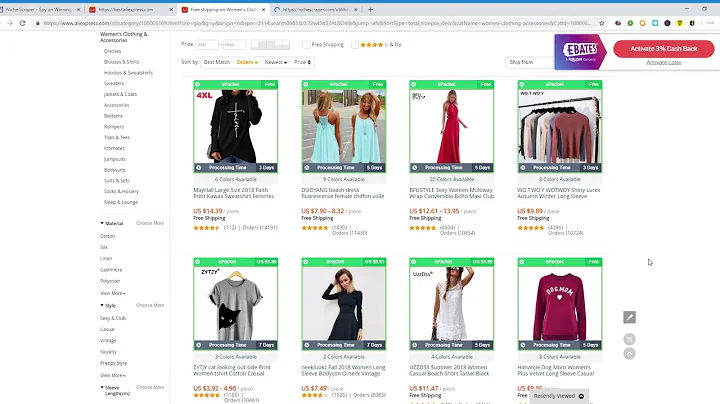Mastering SEO Keyword Research: Find the Perfect Keywords for Your Site
Table of Contents
- Introduction
- Understanding Search Intent
- Short Tail vs. Long Tail Keywords
- The SERP and Search Results
- Using the Google Keyword Planner
- Categorizing Keywords
- Examples: Farmhouse Tables, Farmhouse Nightstands
- Breaking Down Long Tail Keywords
- Examples: Farmhouse Coffee Tables, Farmhouse Bedding
- Competitor Keyword Research
- Utilizing Tools like Keywords Everywhere
- Creating an Organized Keyword Research List
- Optimizing Pages for Short Tail Keywords
- Conclusion
Introduction
Welcome to the ultimate guide on SEO keyword research. In this article, we will explore the step-by-step process of conducting effective keyword research for Search Engine Optimization. Keywords are an essential component of SEO as they help your website rank higher in search engine results and attract targeted organic traffic. By understanding search intent, categorizing keywords, and breaking them down into long tail variations, you can optimize your website for better visibility and conversion rates. Additionally, we will discuss tools such as the Google Keyword Planner and Keywords Everywhere to assist you in finding the most relevant keywords for your niche. Let's dive in!
Understanding Search Intent
Before we delve into keyword research, it's crucial to understand the concept of search intent. Search intent refers to the purpose behind a user's search query. Different search terms can have different meanings and evoke different search engine results. For instance, the search results for "volleyball nets for backyard" will focus on products available for purchase, whereas "how to play volleyball" will display guides, tutorials, and instructional videos. By analyzing search intent, you can tailor your content to address the specific needs and goals of your target audience.
Short Tail vs. Long Tail Keywords
When it comes to choosing keywords for your website, you will come across two main types: short tail and long tail keywords. Short tail keywords are concise and general search terms that often have high search volume but intense competition. Long tail keywords, on the other hand, are more specific and detailed phrases that have lower search volume but higher conversion rates. While short tail keywords provide broader visibility, long tail keywords help you target a more niche audience. It is recommended to utilize both types of keywords in your SEO strategy to achieve a comprehensive approach.
The SERP and Search Results
The SERP, or Search Engine Results Page, is the page displayed by a search engine in response to a user's query. It shows a list of results for a particular keyword or search phrase. Understanding how the SERP looks for your target keywords is vital for creating effective SEO strategies. By observing the search results, advertisements, and related search queries, you can gain valuable insights into user intent and plan your content accordingly.
Using the Google Keyword Planner
The Google Keyword Planner is a powerful tool for keyword research and can provide valuable data to optimize your website. Accessible through the Google Ads platform, the Keyword Planner allows you to discover new keywords based on specific search terms or your website's URL. By entering relevant keywords and analyzing their average monthly search volume, you can obtain a list of potential keywords to target. Additionally, the Keyword Planner offers insights into trends, competition, and other essential data for effective keyword selection.
Categorizing Keywords
To effectively manage and utilize your keyword research findings, it is crucial to categorize your keywords. By organizing keywords into relevant categories and subcategories, you can create a more structured and navigable website. For example, if your website focuses on farmhouse furniture, you can categorize keywords into subcategories like farmhouse tables, nightstands, and beds. This categorization helps you better understand the demands and preferences of your target audience, allowing you to create more targeted content and product offerings.
Breaking Down Long Tail Keywords
Long tail keywords are a valuable asset in your SEO strategy as they offer a higher chance of conversion. To optimize your website for long tail variations, it is essential to break down these keywords further. For instance, if you are targeting the keyword "farmhouse bedding," you can explore related keywords such as "farmhouse quilts," "shabby chic farmhouse bedding," or "farmhouse comforter sets." By creating dedicated pages and content for these long tail keywords, you can target a more specific audience and increase your chances of ranking higher in search engine results.
Competitor Keyword Research
Analyzing your competitors' keywords can provide valuable insights into the most relevant and effective keywords for your industry. By examining the keywords that your competitors are ranking for, you can identify potential gaps in your own keyword strategy and discover new keyword opportunities. Tools like the Google Keyword Planner allow you to enter competitor websites and retrieve a list of their most popular keywords. By incorporating competitor keyword research into your strategy, you can optimize your website to better compete in the search engine rankings.
Utilizing Tools like Keywords Everywhere
Keywords Everywhere is a browser plugin that enhances your keyword research by providing related keyword suggestions, search volumes, and trend data directly within your search engine results page. By installing Keywords Everywhere and configuring it to display relevant data for your target keywords, you can quickly gather valuable insights while conducting online research. This tool can help you find long tail keywords, understand search volumes, and refine your keyword strategy.
Creating an Organized Keyword Research List
To effectively utilize your keyword research, it is crucial to create a well-organized keyword list. By categorizing keywords and subcategories, you can create a comprehensive overview of all the keywords you want to target. Use spreadsheet software or dedicated keyword research tools to compile and manage your list. Include relevant data such as average monthly search volume, competition level, and keyword difficulty to prioritize and tailor your SEO efforts. Regularly update and refine your keyword list to adapt to changes in search trends and user behavior.
Optimizing Pages for Short Tail Keywords
Once you have your keyword research list, it's time to optimize specific pages or sections of your website for short tail keywords. Short tail keywords tend to have higher search volume but also more intense competition. By optimizing your website's pages for these keywords, you increase your chances of ranking higher in search engine results. Ensure that your content and meta information align with the search intent behind these keywords, providing valuable and relevant information to users.
Conclusion
In conclusion, conducting effective SEO keyword research is crucial for achieving higher visibility in search engine results and driving targeted organic traffic to your website. By understanding search intent, categorizing keywords, and focusing on long tail variations, you can optimize your website to match the demands and preferences of your target audience. Utilize tools like the Google Keyword Planner and Keywords Everywhere to enhance your research process and refine your keyword strategy. With a well-organized keyword research list and strategic optimization, you can improve your website's visibility, drive organic traffic, and ultimately boost your conversions and revenue.






















